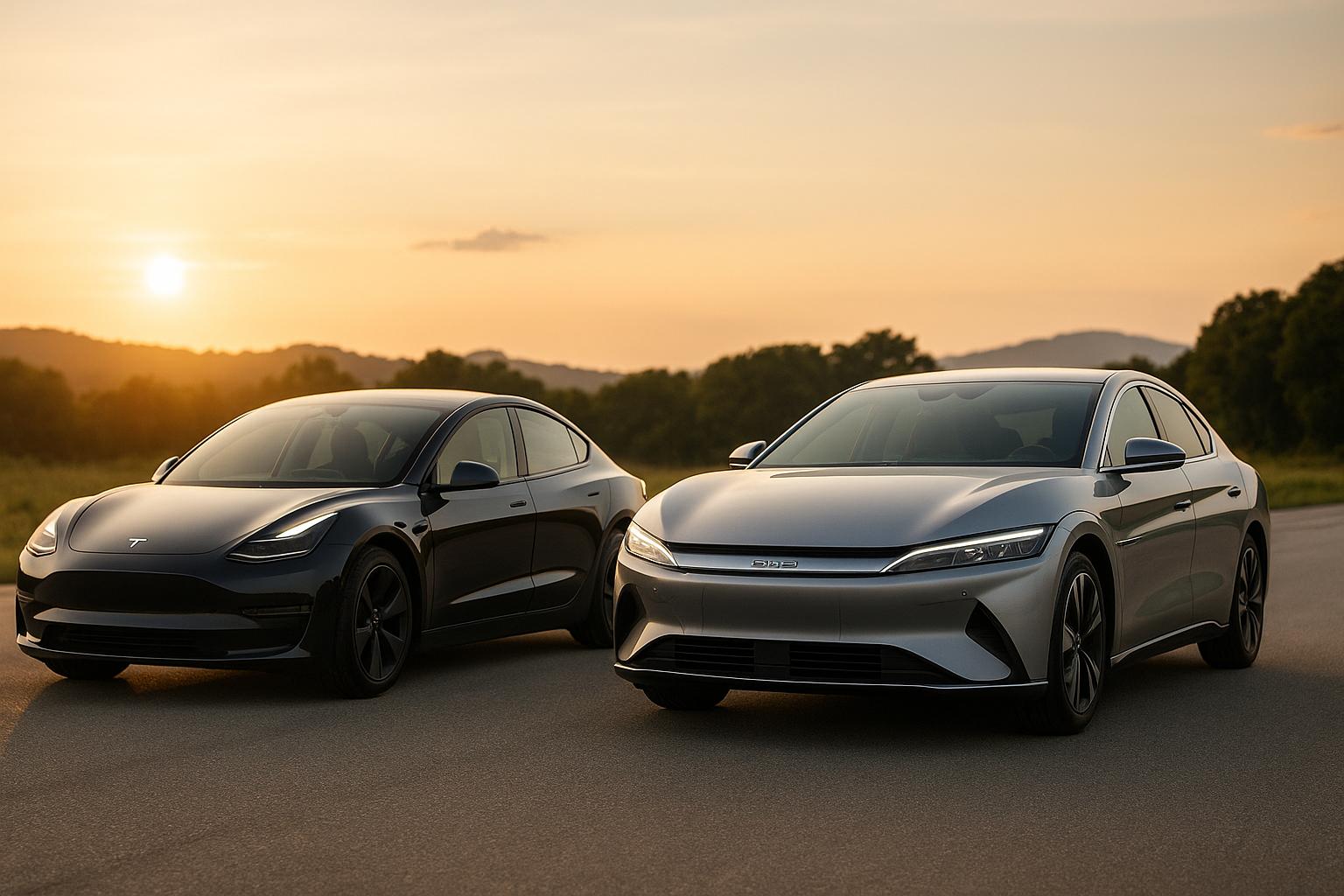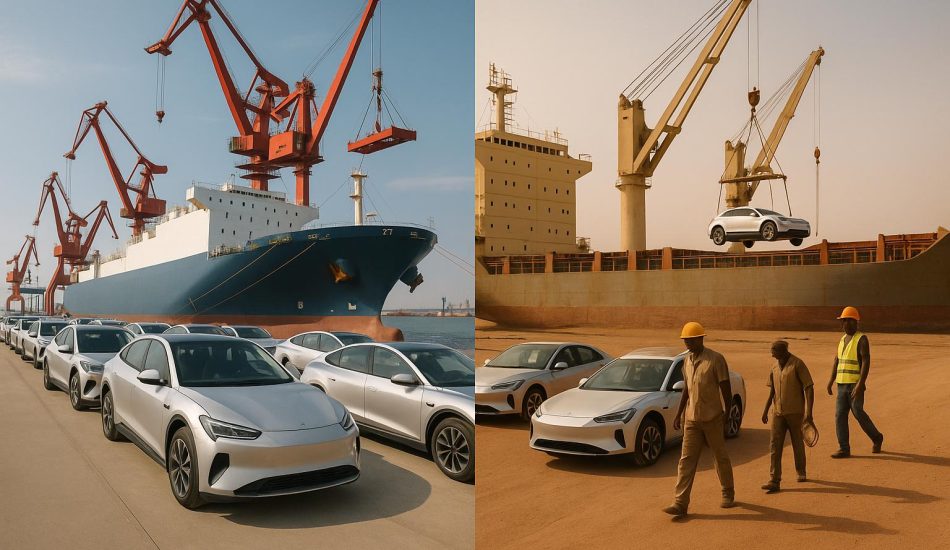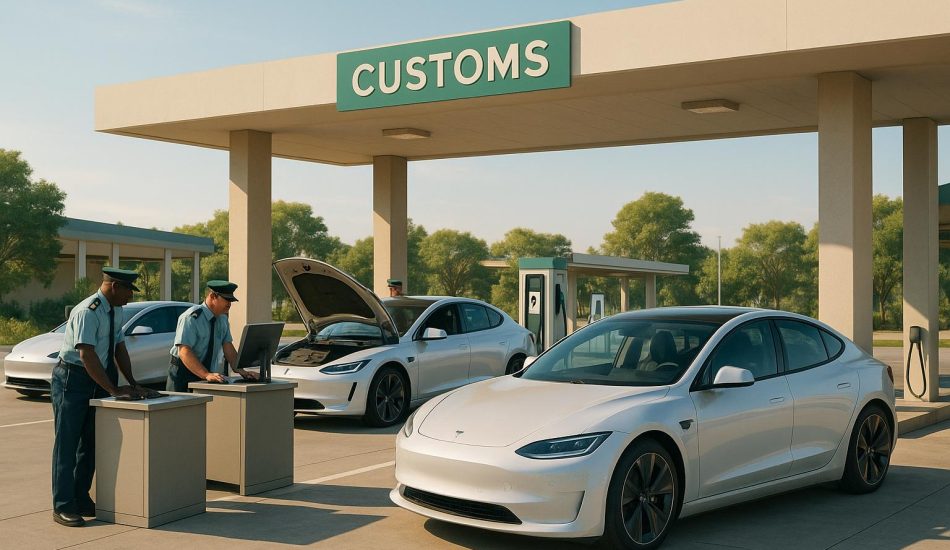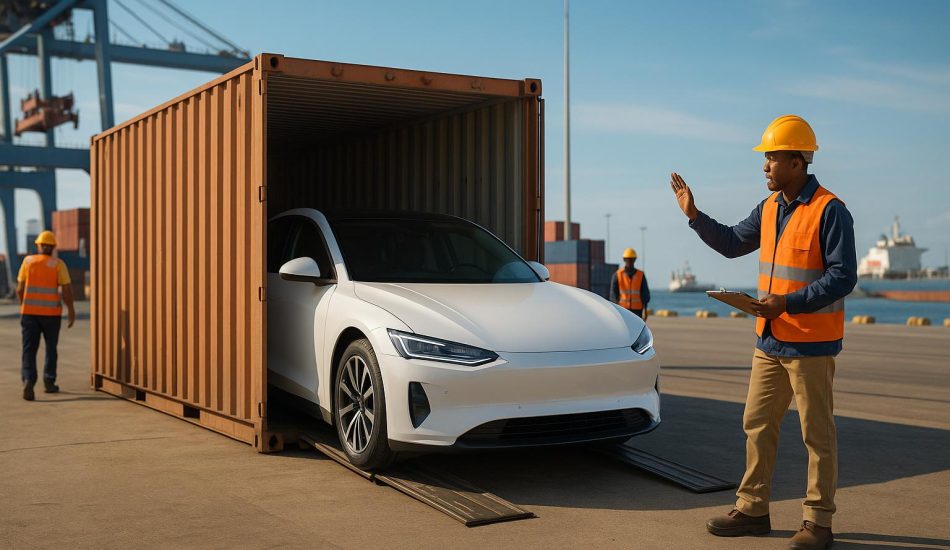
Tesla leads the race in acceleration, with models like the Model S Plaid reaching 0-60 mph in an astonishing 2.1 seconds and the Model 3 Performance at 2.9 seconds. BYD, while slightly slower, offers competitive options like the Seal AWD, which clocks 0-62 mph in 3.8 seconds, and the Sealion 7 Excellence AWD at 4.35 seconds. Tesla consistently outpaces BYD in speed, but BYD counters with more affordable pricing, making it a strong contender for budget-conscious buyers.
Quick Comparison
| Model | 0-60 mph Time | Drivetrain | Horsepower | Torque (lb-ft) | Weight (lbs) | Price Range |
|---|---|---|---|---|---|---|
| Tesla Model 3 Performance | 2.9s | AWD | ~500 | N/A | ~4,000 | $54,000+ |
| Tesla Model Y Long Range | 4.1–4.8s | AWD | 507 | 364 | 4,409 | $58,500–$67,600 |
| BYD Seal AWD | 3.8s (0–62) | AWD | ~530 | 509 | ~4,400 | $45,000–$55,000 |
| BYD Sealion 7 AWD | 4.35s | AWD | 530 | 509 | 5,291 | $61,100–$76,700 |
| BYD Atto 3 | 7.3s | FWD | N/A | N/A | N/A | Under $40,000 |
Tesla dominates in raw speed, while BYD offers strong value at lower price points. Your choice depends on whether acceleration or affordability matters more for your needs.
Tesla Model 3 v BYD Seal: DRAG RACE
Tesla Models: 0-60 MPH Acceleration Times
Tesla’s cutting-edge battery systems, dual-motor configurations, and finely tuned traction control combine to deliver jaw-dropping acceleration. Here’s a closer look at how each Tesla model performs.
Tesla Model 3 Performance
The Model 3 Performance rockets from 0 to 60 mph in just 2.9 seconds, earning its place as one of the fastest sedans on the market. Despite its supercar-level speed, the price remains approachable, starting between $53,000 and $55,000. With about 500 horsepower and a dual-motor all-wheel-drive system, it offers instant torque and impressive grip, making it a thrill to drive.
Tesla Model Y Long Range AWD
Blending utility with speed, the Model Y Long Range AWD accelerates from 0 to 60 mph in 4.33 to 4.82 seconds. With 507 horsepower and 364 lb-ft of torque, this electric SUV proves that you don’t have to sacrifice performance for space. Its price, ranging from roughly $58,500 to $67,600, makes it a premium option for those seeking both versatility and quick acceleration.
Tesla Model S Plaid
The Model S Plaid is in a league of its own, reaching 0 to 60 mph in a blistering 2.1 seconds. Powered by a tri-motor all-wheel-drive system delivering over 1,000 horsepower, it pairs raw speed with advanced battery tech, a low center of gravity, and fine-tuned traction control. Starting at $89,990, the Model S Plaid is a high-end choice for those chasing ultimate electric performance.
BYD Models: 0-60 MPH Acceleration Times
BYD has stepped up to compete in the EV market by offering models that combine impressive acceleration with affordability. Much like Tesla, BYD showcases how electric vehicles can deliver both speed and value. Here’s a closer look at the performance of BYD’s key models.
BYD Seal AWD
The Seal AWD is BYD’s performance standout, reaching 0-62 mph in just 3.8 seconds. This dual-motor, all-wheel-drive sedan delivers around 530 horsepower and 509 lb-ft of torque, making it a true sports sedan. While not as quick as the Tesla Model 3 Performance, the Seal AWD’s acceleration and pricing – ranging between $45,000 and $55,000 – make it a strong competitor. Its advanced battery technology and efficient powertrain contribute to its swift performance. For those seeking a more relaxed ride, the rear-wheel-drive version offers a 0-62 mph time of 5.9 seconds, catering to drivers who value range over top-tier speed.
BYD Sealion 7 Excellence AWD
For those who prefer SUVs, the Sealion 7 Excellence AWD blends performance with practicality. Depending on the trim level, its 0-60 mph times range from 4.35 to 6.49 seconds. Equipped with a powerful dual-motor system generating 530 horsepower and 509 lb-ft of torque, the Sealion 7 proves that SUVs can bring excitement to the table. However, its hefty weight of 5,291 pounds does temper its acceleration compared to lighter sedans. While it boasts more horsepower than the Tesla Model Y’s 507 hp, the added mass prevents it from matching Tesla’s SUV in straight-line speed. With pricing starting at $61,100 and climbing to around $76,700 for top trims, the Sealion 7 offers a mix of family-friendly utility and spirited driving.
BYD Atto 3
The Atto 3 focuses on being an affordable and practical choice rather than a high-speed performer. Its 0-60 mph time of approximately 7.3 seconds reflects its mission to attract EV buyers looking for efficiency and cost-effectiveness. This model is ideal for daily driving, offering smooth and predictable performance rather than sports car thrills. Typically priced under $40,000, the Atto 3 is perfect for those who prioritize budget, range, and usability. Its acceleration is more than sufficient for everyday needs, from city commutes to highway merging.
sbb-itb-99e19e3
Tesla vs BYD: Side-by-Side Acceleration Comparison
Performance Comparison Table
Here’s a quick look at how some of Tesla’s and BYD’s key models stack up in terms of performance:
| Model | 0-60 mph Time | Drivetrain | Horsepower | Torque (lb-ft) | Weight (lbs) | Price Range |
|---|---|---|---|---|---|---|
| Tesla Model 3 Performance | 2.9s | AWD | ~500 | N/A | ~4,000 | $54,000+ |
| Tesla Model Y Long Range AWD | 4.1–4.8s | AWD | 507 | 364 | 4,409 | $58,500–$67,600 |
| BYD Seal AWD | 3.8s (0–62) | AWD | ~530 | 509 | ~4,400 | $45,000–$55,000 |
| BYD Sealion 7 Excellence AWD | 4.35s | AWD | 530 | 509 | 5,291 | $61,100–$76,700 |
| BYD Atto 3 | 7.3s | FWD | N/A | N/A | N/A | Under $40,000 |
The Tesla Model 3 Performance leads the pack with a blistering 0-60 mph time of 2.9 seconds. Meanwhile, the BYD Seal AWD delivers a respectable 3.8-second 0-62 mph time, offering a strong mid-range option at a more affordable price point.
Factors That Affect Acceleration
Acceleration numbers don’t tell the whole story. Several factors influence how quickly a car can get off the line:
- Weight: Lighter cars tend to accelerate faster. For instance, the Tesla Model Y AWD’s lighter weight (4,409 lbs) gives it an edge over the heavier BYD Sealion 7 AWD (5,291 lbs), even though the BYD produces more horsepower and torque.
- Drivetrain Configuration: AWD systems generally offer better traction and quicker acceleration compared to RWD or FWD setups.
- Power Delivery: Tesla’s advanced motor technology and battery systems excel at efficiently converting power into speed, which often translates into better performance numbers.
For example, the Tesla Model Y AWD clocks a 0-60 mph time of 4.33 seconds, narrowly beating the BYD Sealion 7 AWD’s 4.35 seconds. Over a quarter-mile, the Tesla finishes in 12.4 seconds, compared to BYD’s 12.8 seconds. Similarly, the BYD Seal AWD showcases a clear performance boost in its AWD configuration (3.8 seconds) versus its RWD counterpart (around 5.9 seconds).
Which Brand Has Better Acceleration?
When comparing acceleration, Tesla generally takes the lead. The Model 3 Performance stands out in the ultra-high-performance category, while the BYD Seal AWD holds its own in the mid-range AWD segment, outperforming the Tesla Model Y Long Range AWD (4.1–4.8 seconds) with its 3.8-second time.
For everyday driving, these differences may feel subtle during routine commutes. However, they become more apparent during situations like merging onto highways, overtaking, or spirited driving. Enthusiasts who value speed and responsiveness will likely lean toward Tesla’s offerings.
That said, BYD presents a compelling value proposition. The Seal AWD delivers impressive acceleration at a lower price compared to Tesla’s similar models. BYD even highlights its 3.8-second 0-62 mph time with a badge on the car – a nod to its performance credentials.
In the SUV category, Tesla’s lighter construction gives it a noticeable edge over BYD’s heavier SUVs. This difference plays a role not only in acceleration but also in overall efficiency and driving dynamics. Ultimately, the choice between Tesla and BYD comes down to individual priorities – whether it’s raw speed, affordability, or a balance of both.
Conclusion: Tesla vs BYD Acceleration Performance
Tesla takes the lead in acceleration, with the Model 3 Performance hitting 0-60 mph in just 2.9 seconds and the Model S Plaid achieving it in under 2 seconds. BYD’s Seal AWD, while not as fast, still offers a respectable 3.8-second sprint, showcasing competitive performance.
For African buyers, these numbers provide valuable insights into driving dynamics. Acceleration can matter for those who enjoy sporty driving or need quick overtaking ability, but it’s often weighed against other priorities like price, range, and after-sales support. In regions where road conditions and speed limits differ from those in the U.S. or Europe, factors like reliability, affordability, and range might take precedence over sheer speed.
Pricing is another critical factor. For instance, the BYD Sealion 7 Excellence AWD is priced at $76,700, while Tesla’s Model Y Long Range AWD comes in at $67,600, offering similar acceleration but at a lower cost. This price difference could influence decisions, especially for budget-conscious buyers.
In everyday driving, the difference between a 4-second and a 6-second 0-60 mph time might feel negligible compared to considerations like comfort, range, and charging convenience. That said, faster acceleration can enhance safety during overtaking, adding a layer of practicality to performance.
Platforms like EV24.africa make it easier for African buyers to explore options from Tesla and BYD by offering detailed listings, transparent U.S. dollar pricing, and delivery across 54 countries. This accessibility allows buyers to align performance preferences with their practical needs.
While Tesla holds the edge in acceleration, BYD is steadily closing the gap. For African buyers, this competition translates into more choices, clearer pricing, and easier access to electric vehicles tailored to their priorities.
FAQs
How does Tesla’s 0-60 mph acceleration compare to BYD’s in real-world driving?
Tesla has earned a reputation for its jaw-dropping acceleration, with models like the Tesla Model S Plaid capable of going from 0 to 60 mph in less than 2 seconds under ideal conditions. On the other hand, BYD leans more toward affordability and everyday practicality. That said, some of BYD’s higher-performance models still deliver impressive acceleration, though they don’t quite match Tesla’s raw speed.
If you’re interested in exploring the performance and features of Tesla and BYD vehicles further, there are plenty of trusted platforms dedicated to electric vehicles that can help you find options suited to your needs.
What should I consider besides 0-60 mph acceleration when deciding between Tesla and BYD models?
When comparing Tesla and BYD models, there’s a lot more to consider than just how quickly they go from 0 to 60 mph. Key factors include range per charge, the availability and convenience of charging stations, vehicle pricing, and standout features like autonomous driving capabilities or advanced interior tech. It’s also worth looking into build quality, warranty coverage, and potential long-term maintenance expenses.
Your personal needs play a big role too. Think about things like your daily commute distance or whether you need a vehicle suitable for a larger family. Both Tesla and BYD deliver impressive performance, but the best choice ultimately comes down to your specific priorities and budget.
How do Tesla and BYD models compare in terms of affordability for budget-conscious buyers?
Tesla and BYD approach the electric vehicle market from different angles, which directly affects their price points and appeal to various buyers. BYD vehicles are typically more budget-friendly, aiming to attract entry-level and mid-range buyers. In contrast, Tesla leans toward the premium segment, emphasizing high performance and advanced technology, which often comes with a higher price tag.
If keeping costs low is your main concern, BYD provides attractive pricing while still delivering essential features. Tesla, however, is designed for those ready to spend more for top-tier technology and performance. Deciding which brand suits you best depends on your budget and what you value most in an electric vehicle.




